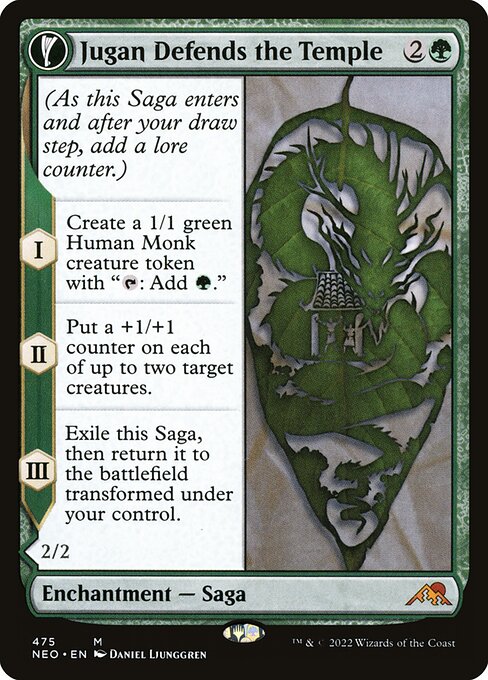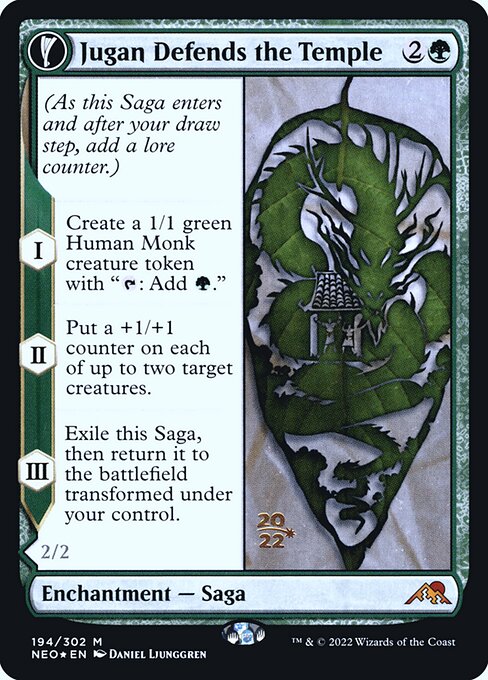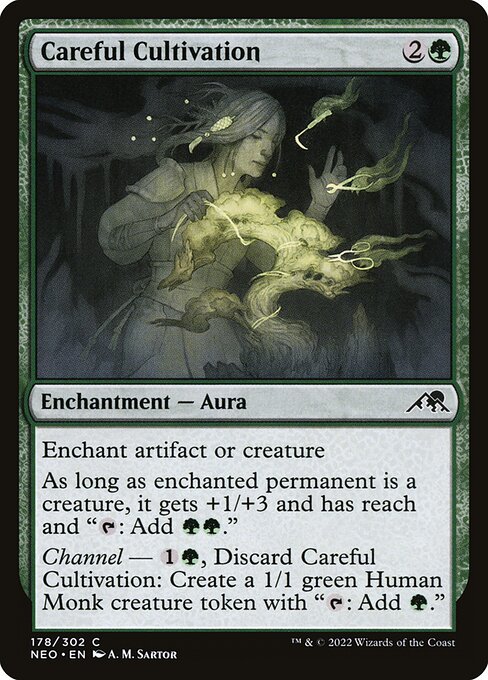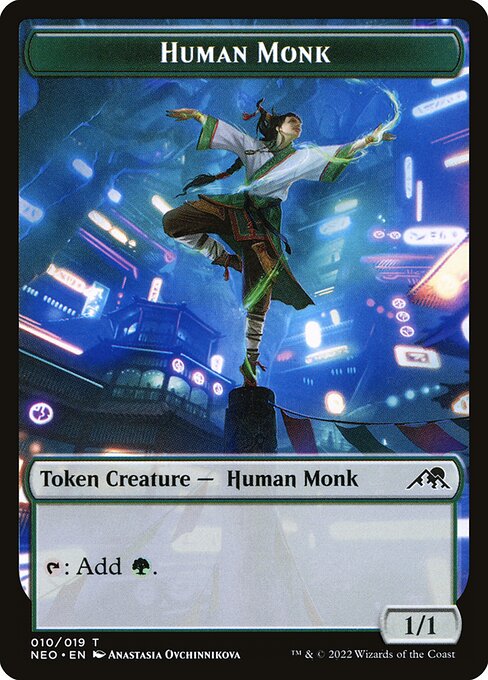Jugan Defends the Temple // Remnant of the Rising Star
//
Enchantment — Saga // Enchantment Creature — Dragon Spirit
(As this Saga enters and after your draw step, add a lore counter.)
I — Create a 1/1 green Human Monk creature token with ": Add ."
II — Put a +1/+1 counter on each of up to two target creatures.
III — Exile this Saga, then return it to the battlefield transformed under your control. // Flying
Whenever another creature enters the battlefield under your control, you may pay . When you do, put X +1/+1 counters on that creature.
As long as you control five or more modified creatures, Remnant of the Rising Star gets +5/+5 and has trample. (Equipment, Auras you control, and counters are modifications.)
I — Create a 1/1 green Human Monk creature token with ": Add ."
II — Put a +1/+1 counter on each of up to two target creatures.
III — Exile this Saga, then return it to the battlefield transformed under your control. // Flying
Whenever another creature enters the battlefield under your control, you may pay . When you do, put X +1/+1 counters on that creature.
As long as you control five or more modified creatures, Remnant of the Rising Star gets +5/+5 and has trample. (Equipment, Auras you control, and counters are modifications.)
2/2
standard
future
historic
gladiator
pioneer
explorer
modern
legacy
pauper
vintage
penny
commander
brawl
alchemy
paupercommander
duel
oldschool
premodern
Rulings
An Aura controlled by an opponent does not cause a creature you control to be modified.
A creature with a counter on it is considered modified no matter what kind of counter it is or which player put it on that creature.
Each face of a transforming double-faced card has its own set of characteristics: name, types, subtypes, abilities, and so on. While a transforming double-faced permanent is on the battlefield, consider only the characteristics of the face that's currently up. The other set of characteristics is ignored.
Only creatures can be modified. If a modified creature stops being a creature, it is no longer considered modified.
The mana value of a transforming double-faced card is the mana value of its front face, no matter which face is up.
The back face of a transforming double-faced card usually has a color indicator that defines its color.
A creature that is equipped is considered modified no matter who controls the Equipment that's attached to it.
Each transforming double-faced card in this set is cast face up. In every zone other than the battlefield, consider only the characteristics of its front face. If it is on the battlefield, consider only the characteristics of the face that's up; the other face's characteristics are ignored.
A transforming double-faced card enters the battlefield with its front face up by default, unless a spell or ability instructs you to put it onto the battlefield transformed or you cast it transformed, in which case it enters with its back face up.
If you are instructed to put a card that isn't a double-faced card onto the battlefield transformed, it will not enter the battlefield at all. In that case, it stays in the zone it was previously in. For example, if a single-faced card is a copy of Azusa's Many Journeys, the chapter III ability will cause it to be exiled and then remain in exile.
A creature with a counter on it is considered modified no matter what kind of counter it is or which player put it on that creature.
Each face of a transforming double-faced card has its own set of characteristics: name, types, subtypes, abilities, and so on. While a transforming double-faced permanent is on the battlefield, consider only the characteristics of the face that's currently up. The other set of characteristics is ignored.
Only creatures can be modified. If a modified creature stops being a creature, it is no longer considered modified.
The mana value of a transforming double-faced card is the mana value of its front face, no matter which face is up.
The back face of a transforming double-faced card usually has a color indicator that defines its color.
A creature that is equipped is considered modified no matter who controls the Equipment that's attached to it.
Each transforming double-faced card in this set is cast face up. In every zone other than the battlefield, consider only the characteristics of its front face. If it is on the battlefield, consider only the characteristics of the face that's up; the other face's characteristics are ignored.
A transforming double-faced card enters the battlefield with its front face up by default, unless a spell or ability instructs you to put it onto the battlefield transformed or you cast it transformed, in which case it enters with its back face up.
If you are instructed to put a card that isn't a double-faced card onto the battlefield transformed, it will not enter the battlefield at all. In that case, it stays in the zone it was previously in. For example, if a single-faced card is a copy of Azusa's Many Journeys, the chapter III ability will cause it to be exiled and then remain in exile.
Rulings
An Aura controlled by an opponent does not cause a creature you control to be modified.
A creature with a counter on it is considered modified no matter what kind of counter it is or which player put it on that creature.
Each face of a transforming double-faced card has its own set of characteristics: name, types, subtypes, abilities, and so on. While a transforming double-faced permanent is on the battlefield, consider only the characteristics of the face that's currently up. The other set of characteristics is ignored.
Only creatures can be modified. If a modified creature stops being a creature, it is no longer considered modified.
The mana value of a transforming double-faced card is the mana value of its front face, no matter which face is up.
The back face of a transforming double-faced card usually has a color indicator that defines its color.
A creature that is equipped is considered modified no matter who controls the Equipment that's attached to it.
Each transforming double-faced card in this set is cast face up. In every zone other than the battlefield, consider only the characteristics of its front face. If it is on the battlefield, consider only the characteristics of the face that's up; the other face's characteristics are ignored.
A transforming double-faced card enters the battlefield with its front face up by default, unless a spell or ability instructs you to put it onto the battlefield transformed or you cast it transformed, in which case it enters with its back face up.
If you are instructed to put a card that isn't a double-faced card onto the battlefield transformed, it will not enter the battlefield at all. In that case, it stays in the zone it was previously in. For example, if a single-faced card is a copy of Azusa's Many Journeys, the chapter III ability will cause it to be exiled and then remain in exile.
A creature with a counter on it is considered modified no matter what kind of counter it is or which player put it on that creature.
Each face of a transforming double-faced card has its own set of characteristics: name, types, subtypes, abilities, and so on. While a transforming double-faced permanent is on the battlefield, consider only the characteristics of the face that's currently up. The other set of characteristics is ignored.
Only creatures can be modified. If a modified creature stops being a creature, it is no longer considered modified.
The mana value of a transforming double-faced card is the mana value of its front face, no matter which face is up.
The back face of a transforming double-faced card usually has a color indicator that defines its color.
A creature that is equipped is considered modified no matter who controls the Equipment that's attached to it.
Each transforming double-faced card in this set is cast face up. In every zone other than the battlefield, consider only the characteristics of its front face. If it is on the battlefield, consider only the characteristics of the face that's up; the other face's characteristics are ignored.
A transforming double-faced card enters the battlefield with its front face up by default, unless a spell or ability instructs you to put it onto the battlefield transformed or you cast it transformed, in which case it enters with its back face up.
If you are instructed to put a card that isn't a double-faced card onto the battlefield transformed, it will not enter the battlefield at all. In that case, it stays in the zone it was previously in. For example, if a single-faced card is a copy of Azusa's Many Journeys, the chapter III ability will cause it to be exiled and then remain in exile.
Your collection? Your decks?
Want to manage your collection and/or create decks?
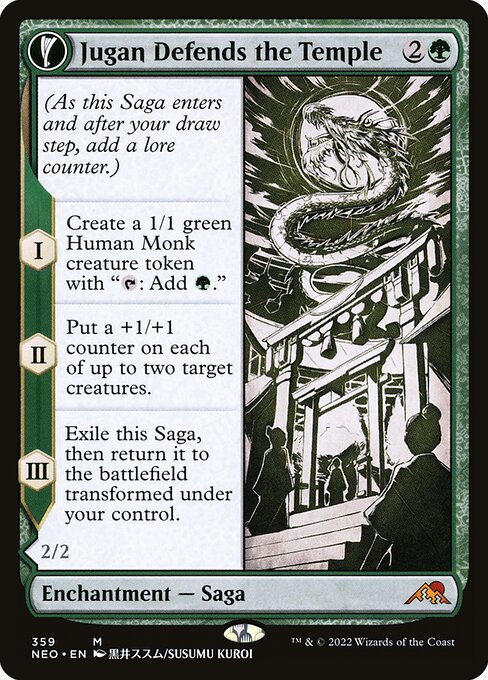

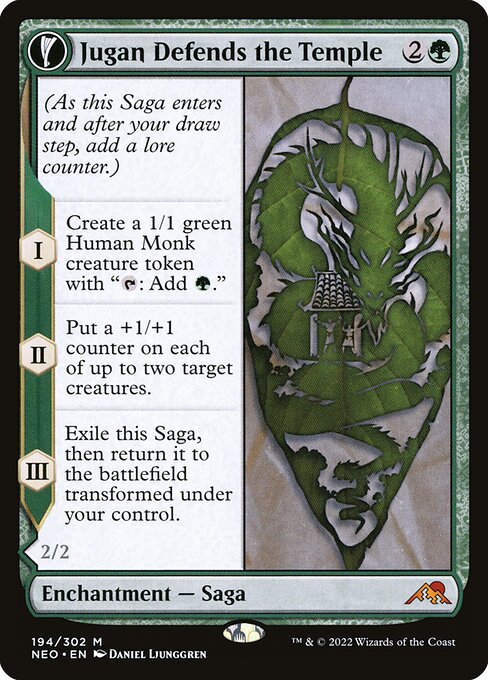
 0
0
 1.36€
1.36€
